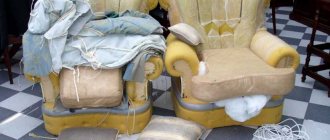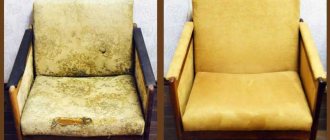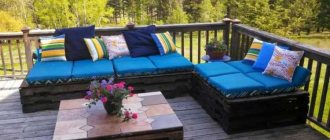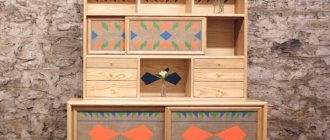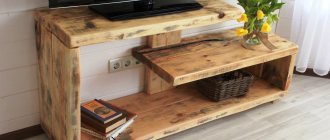Pros of furniture repair
- A good frame gives great advantages in the possibility of restoration. Moreover, old furniture is more reliable and durable.
- The choice of sheathing material is up to the owner;
- Self-restoration of furniture involves the possibility of repairing the frame of a sofa or chair;
- Soviet sofas are more durable and wear-resistant compared to modern upholstered furniture;
- Self-repairs do not require large financial expenditures, which will significantly save the family budget;
- Furniture upholstered with your own hands is unique and inimitable.
Advantages
- Preliminary consultation on cost calculation.
- The work is performed before our eyes, under control.
- No need to transport furniture.
- Delivery of all necessary materials is carried out by the company.
Upholstery selection
The service life of a restored sofa directly depends on the quality of the chosen fabric. Having pets or small children in the house will require dense, easy-to-clean fabric that is resistant to stains and hair sticking.
Mostly jacquard, tapestry, artificial or natural leather, velor or scotchgard are used for upholstery.
Jacquard is a finicky fabric that requires special detergents that do not contain acids. Jacquard emphasizes the elitism of a sofa or armchair, highlighting it with gloss and texture.Tapestry – tapestry fabrics are made based on nature motifs, with a bright and structural pattern. The tapestry is unpretentious to washing and drying parameters and has pleasant tactile qualities.
Leather - a sofa upholstered in leather is capricious in use. A leather bed is not suitable for a sleeping place, but will fit perfectly into the office interior of a study. Long service life leads to cracks and creases in the skin, which does not look aesthetically pleasing and vulgar. Therefore, when choosing leather as upholstery, take into account the purpose of the furniture and the frequency of its use.
Velor is a dense fabric with a velvet structure and a silvery tint. Practical to clean, easy to clean, and can be vacuumed if necessary.
Scotchgard is a modern fabric that allows easy printing; dense, pleasant to the touch, universal for washing and drying. I mostly use Scotchgard as capes.
We recommend reading:
- How to reupholster a sofa with your own hands: dismantling the upholstery, materials and tools, step-by-step guide
- Mineral wool: false naturalness
Assembling a sofa with your own hands: step-by-step instructions with photos and descriptions
The design of a sofa on snake springs and options for its restoration
Snake springs in expensive models are used as an additional means to increase elasticity. In budget models, a foam block can be placed on this base. They are attached to a wooden or metal frame across the seat - each spring separately. The installation step depends on the planned load. If your sofa begins to sag, or the springs have lost their elasticity or are broken, the solution is to replace them.
The spring, due to its elasticity, supports the materials on top. This is what it looks like disassembled. An expensive imported sofa is also made on a snake
To increase elasticity and extend service life, when reupholstering a sofa, the number of “snakes” can be increased. Another option is transverse reinforcement with rigid corsage ribbons (which are used for straps on bags and backpacks).
For durability and greater elasticity, use grosgrain ribbon
The tape is nailed on one side to the frame. Professional furniture makers then tighten it using a special tool, but it can be replaced with a regular block wrapped around the middle with coarse-grain sandpaper. You wrap a couple of turns of tape around this beam, pull with both hands (make sure that the frame does not bend), secure the tape with staples or nails, release and cut off the excess. The same method is also suitable for increasing the service life of a mattress with slats.
How to calculate the required amount of material
Reupholstering upholstered furniture at home is a complex and time-consuming process. In order not to have to sew individual flaps on a sewing machine, you need to take into account the size of the roll of selected fabric. When calculating the required footage, you need to remember the possibility of fabric overlaps. On average, up to 30 cm is taken into account.
Masters advise taking into account two lengths and two widths of the sofa. With this approach there will be no difficulties with calculations.
The decisive aspect is the print of the selected fabric. Drawings and patterns are adjusted to each other and this will require extra meters of fabric.
Independent creative work
Repairing upholstered furniture can be done with your own hands. It will be more economical, but not fast. You can count on one day of work when it comes to a chair. The armchair or sofa may need to be given more time. To ensure that the lack of skills does not affect the result, the issue must be approached responsibly and systematically.
Conventionally, the entire process can be divided into four stages: preparation, disassembling furniture, updating components, and proper assembly. Each segment of the labor-intensive path has its own nuances that must be remembered.
Required Tools
Before upholstering furniture, you need to thoroughly prepare and purchase the necessary tools.
- Stationery knife;
- Tailor's scissors;
- Hammer;
- Flat screwdriver;
- Construction stapler;
- Open-end wrenches.
How to reupholster upholstered furniture is a complex question, but if you follow the tips and rules, you will become a master in this field.
We recommend reading:
- Do-it-yourself upholstery (upholstery) of chairs: 100 photos of ready-made options and unusual designs
- Do-it-yourself furniture decoupage: review of the best techniques, original ideas and beautiful design (140 photos)
- How to update furniture with your own hands - a review of the best ideas for beautiful restoration of home furniture (120 photo ideas)
Features of skin tightness
Genuine leather has good shock-absorbing qualities and is stretchable. Thanks to this, sitting on such seats is convenient and comfortable, but over time the material stretches, forming bubbles. In addition, strong tension can cause holes to tear. In order for the upholstery to remain presentable for as long as possible, it must be nailed in a continuous line as far as possible from the edge of the frame - this will leave enough space for tightening when stretched, which will allow restoration without complete disassembly of the product.
Knowing how to make a sofa for dolls and what materials are required for this, you don’t have to waste...
Reupholstering a kitchen corner with your own hands is an event that, throughout the service life of this interior element...
Do-it-yourself sofa pillows can be made from cotton fabric, linen, flannel, tapestry, silk, calico,…
How to remove old upholstery
It is recommended to carefully cut off the old upholstery using a utility knife in order to later measure out new pieces of fabric using it. The security of fastening with building staples complicates the task, so if necessary, the upholstery is removed and the old staples are driven into the wood. The process of removing upholstery is long and labor-intensive, sometimes difficult even for experienced specialists.
After removing the upholstery, it is recommended to remove the filling and properly dispose of it. It is not worth saving on filler, because mold and dust mites develop in it.
To avoid unexpected damage, furniture is disassembled into its components and carefully inspected for defects. If present, the part is replaced. Metal joints are treated with silicone to prevent corrosion and squeaks.
We count the footage
To calculate the total footage of the fabric used, you should calculate the length and width of each individual part, and then add these parameters. Keep in mind that when working, an allowance may be required, which is formed by increasing the volume of foam rubber or replacing the blocks with newer ones. Therefore, before purchasing, take 1 m more fabric than is needed, because when creating patterns, you will need to take an additional 3-5 cm of stock on each side.
After the footage has been calculated, you can go to the store and look at the assortment. As for the color scheme, the priority was, is and will be graphite, all shades of gray, burgundy and blue. These are the colors that are considered the most practical and not easily soiled for sofas.
How to cut material
Having prepared the furniture for the final stage, we begin cutting out the fabric.
To begin with, filler is sheathed on a wooden furniture frame using a furniture stapler. Two or more fillers are glued together with a special odorless glue.
To ensure a tight fit and reliability, the brackets are shot perpendicular to the beams. There is no need to skimp on braces. If the upholstery or filling comes off after reupholstering, they can be secured after re-disassembly.
There are two ways to cut the upholstery:
- Using old scraps of fabric;
- According to the size of the spilled filler.
The combination of the two methods will not allow you to make mistakes in cutting and adjusting the fabric. In order to eliminate the lack of fabric, it is necessary to add 2-4 cm from the edge as a reserve.
Damage and types of repair
Damage to a sofa or other upholstered furniture can vary in severity. Depending on the existing injuries, a different range of work is required. Here's what can happen to your furniture:
- Only the fabric became unusable (cats tore on the armrests, for example), i.e. There are no dips in the soft part or protruding parts. Then everything is more or less simple and you can get by by replacing the upholstery fabric.
The simplest case is if you need to replace the fabric - There are some dents in some places . This damage is caused by wear and tear on the components that make up the upholstered part of the sofa. Depending on the degree of damage and the design of the sofa itself, it may be necessary to replace padding polyester and other underlying layers. In more severe cases, repair of spring blocks, if any, or foam rubber/silicone if the sofa is spring is required. If the upholstery looks quite good, it can be washed and used again.
- Sink in the bottom of the seat . Sometimes, due to high loads, the springs pierce the bottom of the frame. This happens most often if it is made of fiberboard. In this case, you will have to disassemble everything, remove the spring dock, replace the fiberboard (preferably with plywood). This sufferer needs more than just replacement upholstery...
- Damage to the frame . One of the most unpleasant things is cracks in the frame bars. The sofa will have to be completely disassembled, the broken bars replaced, and then everything restored. This is a complete reupholstery of the sofa. Essentially, you're building a new one.
So reupholstering a sofa can involve different jobs. From simply replacing the upholstery to a complete renovation, including part of the frame. The most troublesome part is with the spring blocks. This is long and painstaking work. If the “historical accuracy” of your furniture is not important to you, it is easier to replace a failed spring block with foam rubber or (better, but more expensive) furniture silicone. If everything is done correctly, the sofa will become even more comfortable: incorrectly tightened springs cause a lot of inconvenience.
Sofa assembly
Restoring upholstered furniture is a reciprocal process, so the sofa is assembled in the reverse order - armrests, pillow and backrest. Before completing the cladding, it is worth checking the strength of the structure and the filler.
Photos of upholstered furniture after reupholstery leave rave reviews. Re-upholstering furniture yourself is difficult and problematic, but the result is worth it. This method of “reviving” old things saves the budget and allows us to preserve things that are dear to us. Upholstered furniture after repair looks like new from the store.
Types of "soft part"
Let's talk in general terms about what the seat and back of the sofa can be made of. There are options:
- Without springs: High-density foam rubber (polyurethane foam, also called PU foam) (also called furniture rubber).
- Foamed latex. In terms of quality and convenience, it is better than foam rubber, but also much more expensive.
- with classic springs connected into one block;
When restoring a sofa, you need to examine the layers.
These are the most common types of sofa seats. In more expensive models, the spring block can be supplemented with a layer of polyurethane foam or latex, which makes the seat more elastic and comfortable at the same time. When reupholstering, they then look at the condition of both parts, replace or leave them - depending on desire and capabilities.
The structure of sofa seats can be multi-layered
But that's not all the layers. In addition to springs, polyurethane foam/latex, padding polyester or thermal felt (or regular felt) are also laid. This is if the sofa is more or less modern and not too expensive. Older exhibits may contain matting or burlap, batting (or something very similar), horsehair, dried seaweed and other now almost exotic materials for sofa stuffing. When repairing a sofa, they will need to be replaced with the same ones (if you want to look) or similar in thickness and properties. So, to understand how a sofa should be reupholstered, first understand what’s inside it.
Photos of upholstered furniture
Stage V - making a pattern
Once a suitable fabric has been selected, you need to cut it into fragments. To simplify the process, use old upholstery, which must first be shaken out or vacuumed well.
Spread the fabric on the floor and place all the pieces of the old upholstery you removed on it. Keep the layout as compact as possible, but do not forget to leave an allowance around the edges if you need to sew the covers together. Thus, between each part you should have gaps about 8-10 cm wide. Now you need to circle all the elements. Use a bar of soap or chalk for this if the fabric is dark, and a simple pencil if it is light. To avoid the parts moving, you can pin them using sewing pins. Now you need to sew covers for the sides and other elements, if this was the case initially. It’s good if you have a sewing machine at home and you’re comfortable with it. Otherwise, you need to contact the studio for help and be sure to ask that all edges be overlocked. This will protect the edges from fraying.
It is very important to monitor the direction of the weft and warp threads. They must match on all parts
It is very easy to determine - the weft thread stretches, the warp thread does not.
